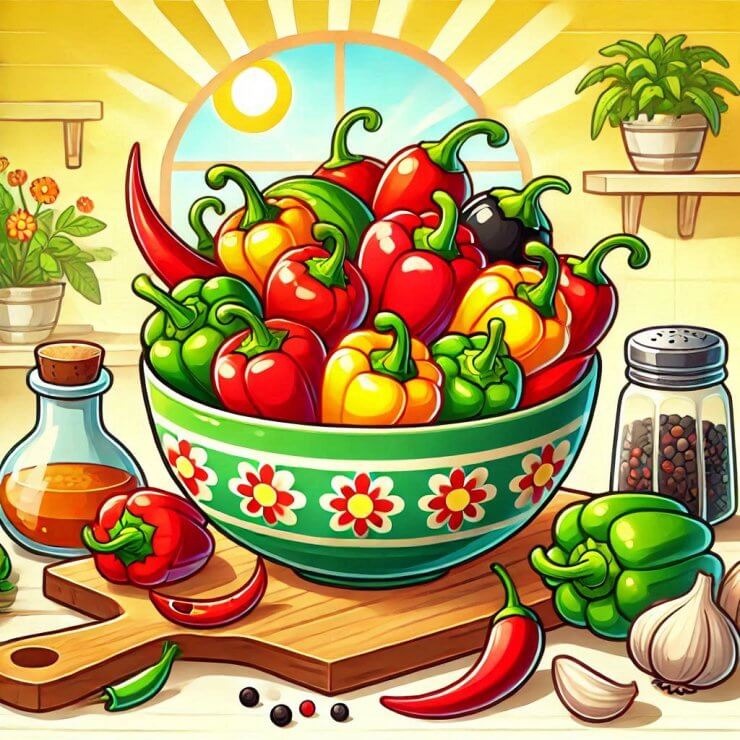Read by Michael Flamel

There’s really nothing quite like hot peppers. Whether it’s the vibrant red, orange, or green hues or the fiery kick they deliver to your taste buds, hot peppers have a way of making their presence known. As a staple in cuisines around the world, these small but mighty pods elevate dishes with their bold heat and distinctive flavor. But beyond their culinary appeal, hot peppers bring an impressive array of health benefits to the table.
The use of hot peppers dates back thousands of years, deeply rooted in traditional medicine and cultural practices across the globe. Native to Central and South America, they were revered by indigenous cultures for their healing properties and were believed to ward off illnesses and improve overall vitality.
From Aztec warriors seeking strength before battle to traditional Chinese medicine using peppers to stimulate circulation, these spicy fruits have long been recognized for their medicinal potential. Today, modern science confirms what ancient civilizations intuitively knew—hot peppers are a natural powerhouse of health.
Packed with essential nutrients and bioactive compounds, hot peppers are rich in capsaicin, the compound responsible for their signature heat. Capsaicin boasts powerful antioxidant and anti-inflammatory properties, making it a valuable ally in promoting heart health, reducing pain, and even aiding in weight management by boosting metabolism. Studies suggest that capsaicin may help lower blood pressure, improve blood circulation, and support the body’s ability to fight infections and inflammation.
Hot peppers also contain an impressive array of vitamins, including vitamin C, which supports immune function, and vitamin A, which promotes healthy vision and skin. The fiery pods are also known to aid digestion by stimulating the production of digestive juices, while their antimicrobial properties help protect against harmful bacteria.
Beyond their internal health benefits, hot peppers have also found their way into natural remedies for pain relief. Capsaicin is a common ingredient in topical creams and ointments used to alleviate muscle and joint pain, providing relief for conditions such as arthritis and nerve pain. And while the heat may make you sweat, it also contributes to the body’s natural detoxification process, helping to eliminate toxins and improve overall well-being.
So, the next time you reach for a hot pepper to spice up your favorite dish, remember that you’re not just adding flavor—you’re also tapping into a centuries-old tradition of health and healing. With their history, versatility, and therapeutic properties, hot peppers prove that sometimes the smallest pods can have the biggest impact on your health.
Here’s a closer look at how hot peppers can enhance your well-being.
Antioxidant Engine for Your Body
Chilipeppers get their heat from compounds called capsaicinoids; that’s the spiciness that makes your eyes water. The capsaicinoid compounds are also antioxidants, fighting off free radicals in your body and providing some measure of protection against infection and the development of some types of cancer.
Capsaicinoids are just one of seven beneficial antioxidants found in chili peppers. While they’re the most famous, hot peppers also contain capsanthin, violaxanthin, lutein, zeaxanthin, sinapic acid, and ferulic acid. The antioxidant levels in chili peppers increase as the peppers ripen.
Blood Pressure Control?
You bet! The capsaicin in hot peppers has analgesic (pain-reducing) and anti-inflammatory properties—both of which can contribute to better heart health. Studies show that capsaicinoids improve the circulation of blood in the heart, increase blood flow to tissues, reduce plaque buildup in blood vessels, reduce the body’s absorption of fat and cholesterol, and lower your blood pressure.
Improving Your Digestive Health
Let’s dispel one rumor right now: eating spicy foods, including foods made with hot peppers, will not give you an ulcer. In fact, the antioxidants in chili peppers may actually help heal some intestinal issues while also promoting gut health. Studies indicate that capsaicin may help provide some protection for the stomach and intestines.
Even Brain Health?
Who knew! Studies have shown that compounds called phenolic acids—especially a compound called p-Coumaric acid—may contribute to better brain health by helping protect against mental decline.
Eye Health, Too!
Chili peppers contain lutein, a nutrient that helps protect your eyes against damage to your photoreceptors because of light exposure. A diet rich in lutein may also help reduce the risk of macular degeneration, a condition that can cause vision loss.
Boost Your Skin Health
The ferulic acid in chili peppers contains antioxidants that can help slow the skin’s aging process by reducing the damage free radicals cause to the skin.
Maintain Healthy Weight
Eating spicy food may give a whole new meaning to burning calories. One study shows that chili peppers contain compounds that increase heat production and fat metabolism. Capsaicin, the most well-known compound in chili peppers, may help with weight loss.
Get Pain Relief
It’s important to protect your skin, eyes, and mucous membranes when you’re handling raw hot peppers that rate high on the Scoville scale—a measurement of the spiciness or pungency of peppers and other hot foods. But the capsaicin that can cause such agony (even burns!) from accidental contact can also provide pain relief when prepared and appropriately applied. Capsaicin-infused skin patches and cream can help relieve the discomfort of pulled muscles, arthritis, and fibromyalgia.
Spice of Life?
Eating spicy peppers might even help you live longer. Researchers followed almost half a million people for years. The study indicated that people who ate spicy food once or twice a week had a 10 percent reduction in total mortality. Those who ate spicy food more frequently appeared to increase their chances of longevity even more.
Did you know that hot peppers can be so beneficial and healthful? Please tell us about how you use hot peppers in your recipes by commenting below. ❖


 Previous
Previous


